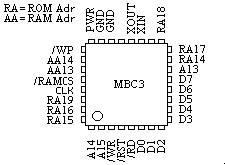Just so we don't exclude any possibilities... What is the speed rating of the flash chip? The speed rating is the last number in the part number, after a dash. It's typically something like -75, -90 or -120 and tells you how many nanoseconds the chip will take to deliver the requested data. Lower is better. -120 should work, -90 should definitely work, but anything above -120 might not. I find it hard to believe that such a big chip would be too slow, but you never know.
Can you tell me something about the scrambled logo?
Does it look the same every time? If no, then something is seriously wrong. ( ![]() )
)
Does it have any resemblance of the Ninty logo? If yes you've probably swapped or otherwise screwed up the data lines.
If neither of those, (same dirt every time) you're reading data from somewhere else in the ROM.
If the flash chip is actually programmed correctly, then there's something wrong with the address lines.
Any unused address pins should be grounded, otherwise they might fluctuate and this can cause a complete failure. However, since your cart doesn't use MBC5, I'm assuming it's using MBC3 or maybe MBC1. (But not MBC2, as MBC2 couldn't even handle the 8 MBit LH538...) Both MBC1 and MBC3 have a max size of 16 MBits, so you should be able to get the full size. You should be able to connect at least A19 by connecting it to A19 of the ROM. If there's only 1 unconnected pin left on the MBC, that's where A20 should go. Or you could ground A20 and live with having only 8 MBits for now.
Oh and if you haven't seen these:
http://www.ziegler.desaign.de/32mbit.htm
and